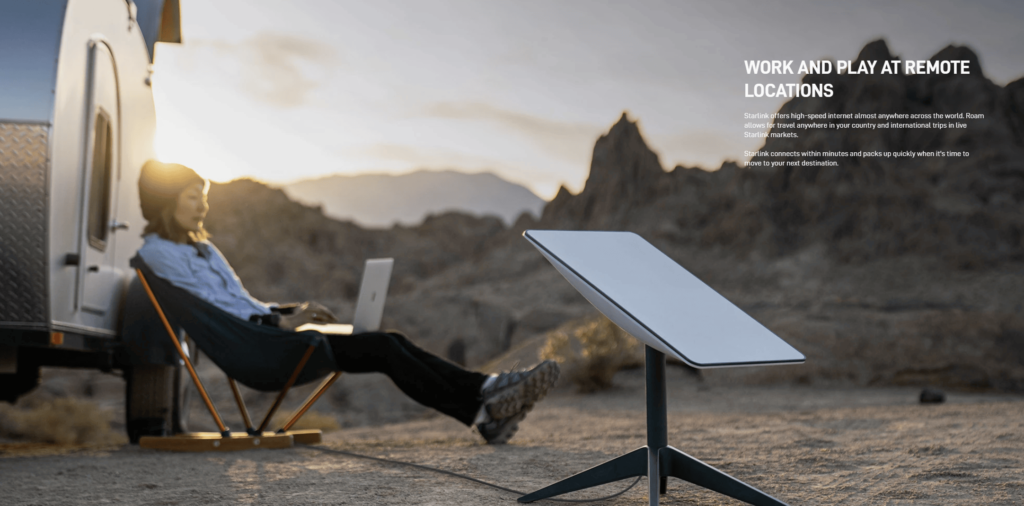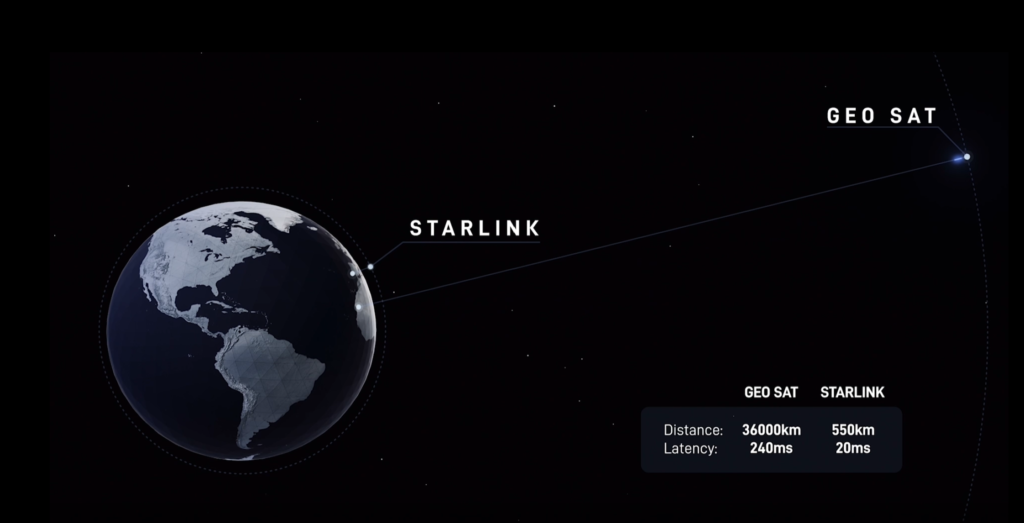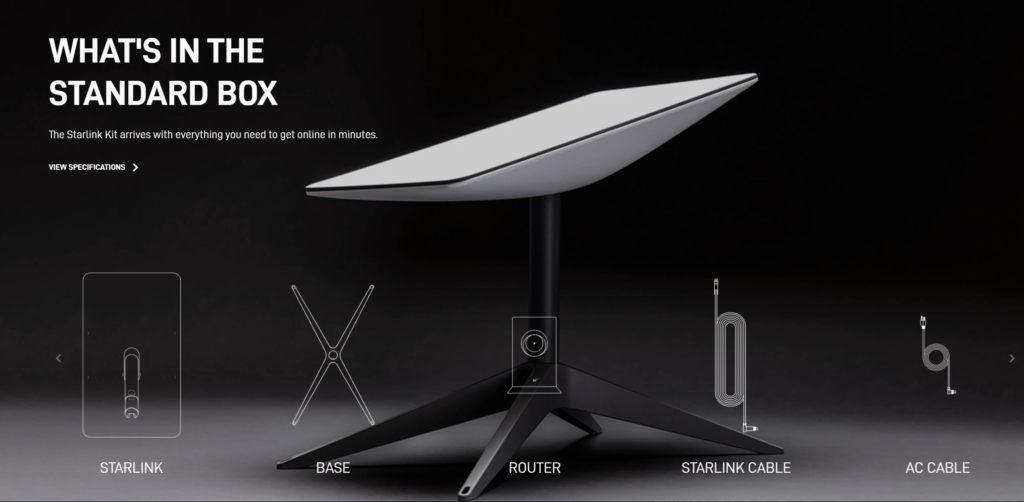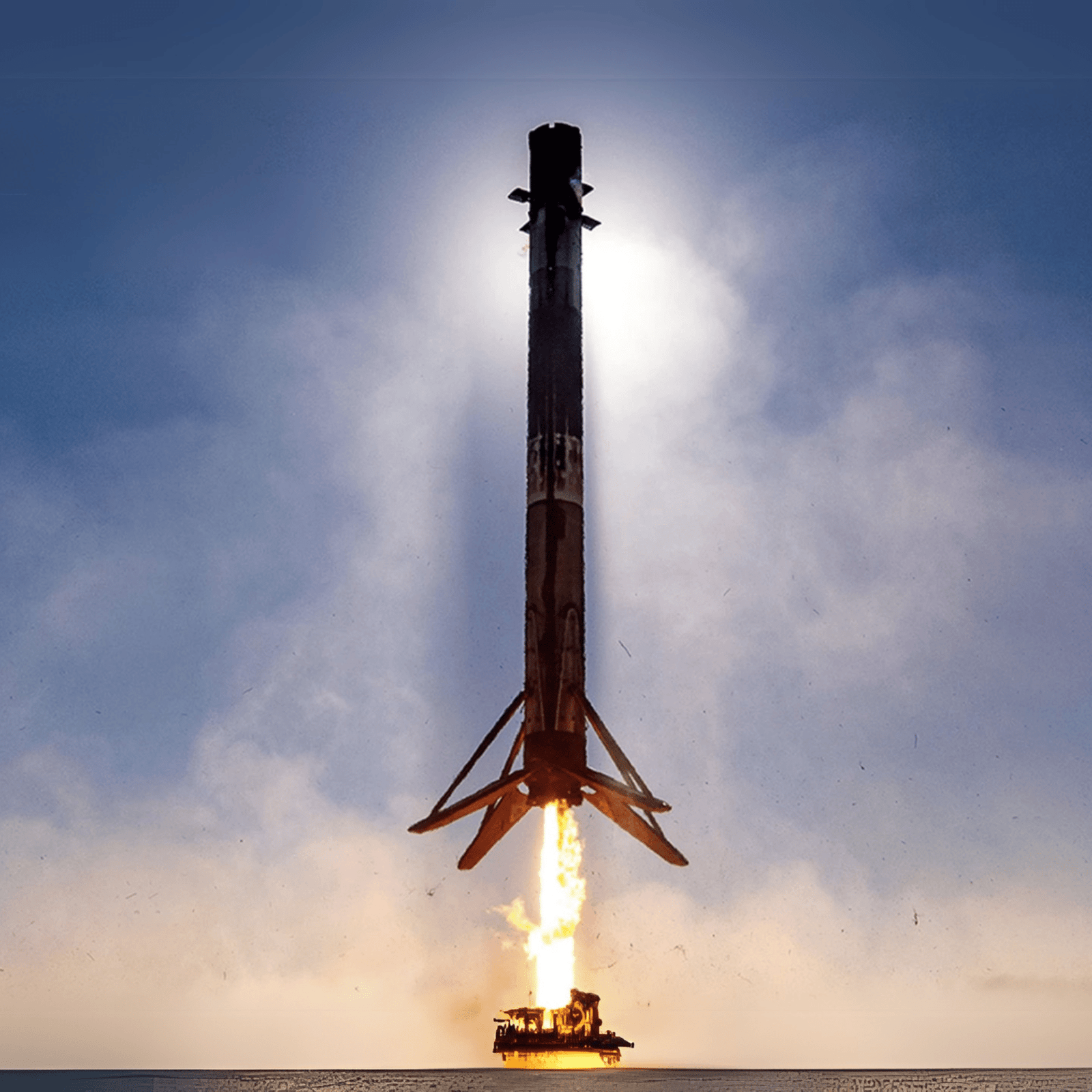Imagine a world where everyone has fast, reliable internet access, no matter where they live. Farmers in remote areas could check market prices instantly, students in isolated communities could participate in online learning, and businesses could thrive regardless of their location. This is the promise of satellite internet – a technology becoming reality.
While satellite internet has been around for some time, recent advancements in technology have made it a more promising solution.
Elon Musk’s SpaceX is a major player in this field with its Starlink project. By launching a constellation of low-orbit satellites, Starlink aims to provide high-speed, low-latency internet access to even the most remote locations.
This article explores Starlink’s technology, benefits, and challenges, and its potential to change the future of internet connectivity.
What is Starlink Internet?

A SpaceX Innovation
Starlink is a network of satellites that provide internet service. It is operated by SpaceX, a private company known for its reusable rockets and space exploration goals. This project uses SpaceX’s knowledge of rockets and spacecraft to launch and maintain thousands of satellites in low Earth orbit (LEO). These satellites work together to beam high-speed internet access to Earth, providing coverage to remote and underserved communities where traditional internet infrastructure is limited.
How Does Starlink Internet Work?
To understand how Starlink internet works, we need to look at its three key components:
- The Role of Low Earth Orbit (LEO) Satellites
Traditional satellite internet services use geostationary orbit (GEO) satellites. These satellites are positioned far above Earth to provide wide coverage. However, this results in high latency, which causes noticeable delays in internet speed.
Starlink, with its thousands of small satellites orbiting Earth at approximately 340 miles (550 km), overcomes this issue. This altitude is considerably lower than GEO satellites, allowing Starlink to achieve significantly lower latency and faster data transfer speeds.
- Starlink Ground Stations
Starlink ground stations are strategically located worldwide. They connect the satellite network to the internet on Earth. These ground stations act as gateways, transmitting and receiving data from the satellites and routing internet traffic between users and the wider internet. SpaceX is continuously expanding its network of ground stations to improve coverage and performance.
- Starlink User Terminals
To access Starlink internet, users need a user terminal, often referred to as “Dishy McFlatface.” This dish-shaped antenna communicates directly with the Starlink satellites to receive and send internet data. It is designed for easy setup and can be installed by anyone without needing special technical skills.
From disaster relief to maritime and aviation connectivity, Starlink is revolutionizing industries by providing reliable internet access where it was once impossible.
Thousands of Satellites
Astronomer Jonathan McDowell has been independently tracking Starlink satellites. As of November 2024, there were 6,764 Starlink satellites in orbit, with most (6,714) actively working. This huge network of satellites is always growing and changing. Each Starlink satellite has a designed lifespan of approximately five years, so they need to be replaced and upgraded continuously. To achieve its goal of global internet coverage, SpaceX plans to deploy a constellation of 42,000 satellites. This would be much larger than any existing satellite network.
Portability and Mobility Options
Staying connected to the internet is essential in today’s world. Starlink offers a variety of mobility solutions designed to bring high-speed internet access to those who travel or live beyond the reach of traditional internet infrastructure.
- Starlink for Recreational Vehicles: This service gives internet access to people in recreational vehicles (RVs), which is perfect for those who travel or live in their RVs.
- Starlink for Maritime: This special service brings fast internet to ships and boats, changing how people communicate while at sea.
- Starlink for Aviation: Starlink is working to bring its service to airplanes, which means people will be able to have fast internet access while flying.
- Starlink Direct to Cell: SpaceX, the company behind Starlink, is working with cellphone companies to connect cellphones directly to satellites. This will help get rid of areas where cellphones do not work and bring service to far-away places.
A Brief History of Starlink
Early Stages and Ambitious Goals
In January 2015, SpaceX first revealed its idea for a network of internet satellites. At that time, it was not yet called Starlink. CEO Elon Musk wanted to create a system that could “rebuild the internet in space.” His initial goal was to put about 4,000 satellites into low Earth orbit. However, the project’s scope has expanded significantly since then. The US Federal Communications Commission (FCC) granted SpaceX a license to operate 12,000 Starlink satellites. Since then, the company has applied for permission to add 30,000 more, bringing the total to 42,000 satellites.
Testing and Launch
Before launching the full set of satellites, SpaceX tested the technology with two Starlink test satellites named TinTinA and TinTinB in February 2018. The test was successful. Based on the information they gathered, SpaceX requested and obtained permission to operate their satellites at a lower altitude than first planned. The first group of 60 Starlink satellites launched on May 23, 2019. They were carried into space on a SpaceX Falcon 9 rocket and successfully reached their working orbit of 340 miles (550 kilometers) above Earth.
Finding Starlink with Your Eyes
Starlink satellites are easy to see in the night sky. They look like a moving train of bright lights. You do not need a telescope or binoculars to see them. They are most visible a day or two after launch, when they are closer together and brighter. As they move to higher orbits, they become harder to spot.
Astronomers have been concerned about the brightness of these satellites. In response, SpaceX has been working to make the satellites less bright. They started a program called “VisorSat” to reduce how much light the satellites reflect. VisorSat satellites have a special sunshade, or “visor”, that blocks sunlight so it does not reflect off the satellite’s bright surfaces.
SpaceX has also tried darker coatings and made changes to how the satellites are positioned to make them less reflective. While these efforts have helped reduce the brightness of Starlink satellites, they have not completely eliminated the problem.
SpaceX is launching thousands of Starlink satellites, aiming for a constellation of 42,000 – a network that could reshape global connectivity.
Starlink vs. Traditional Internet: Key Differences

Starlink Satellite Internet vs. Cable Internet
Cable internet is common in cities and relies on a network of cables to deliver internet service. Cable internet usually offers fast speeds and low lag, but it is only available where the cables are installed. Starlink uses satellites to deliver internet service, so it can reach areas where cable internet is not available.
Starlink Internet vs. Fibre Optic Internet
Fibre optic internet is a technology that uses pulses of light to transmit data through thin glass fibres. This method is known for its blazing-fast speeds and minimal lag, providing a seamless online experience. However, it requires a vast network of cables and equipment to function correctly. This makes it expensive to install in less populated areas, limiting its reach.
Starlink internet does not need the extensive and costly infrastructure of fibre optic cables. Starlink can provide similar speeds to fibre optic internet, even in remote areas.
Starlink Internet vs. Wireless Internet (4G/5G)
Wireless internet uses cellular networks to give us mobile connectivity. However, its coverage and speed can be inconsistent, particularly in rural areas. Starlink, with its network of Low Earth Orbit satellites, aims to provide more consistent high-speed internet access, even in locations where cellular coverage is weak or nonexistent.
Advantages of Starlink Internet
High-Speed Internet in Remote Areas
Starlink’s main advantage is that it can deliver fast internet to remote areas. Because it uses satellites, Starlink can reach places where regular internet service is not possible or not available. This helps rural communities connect to the internet and improve their economies and social development.
Low Latency
Latency, which is the delay in data transmission, is a very important factor affecting internet performance. High latency can make online gaming, video calls, and other real-time applications very slow. Starlink, with its Low Earth Orbit satellites, offers much lower latency compared to traditional satellite internet services. This makes Starlink a good choice for users who need a responsive internet experience, even in remote locations.
Global Coverage
Starlink’s ambitious goal is to provide internet coverage around the world, reaching everywhere. As the constellation grows, Starlink aims to close the digital divide across the globe, connecting billions of people who do not have reliable internet service right now.
A Solution for Underserved Communities
Starlink has the potential to change underserved communities by providing access to the same level of internet connectivity found in cities. This can help individuals, businesses, and schools, leading to economic growth, social development, and equal opportunities for everyone.
Disadvantages of Starlink Internet
Pricing and Affordability
One of the main problems with Starlink internet is its cost. The initial cost of the user terminal and the monthly payments can be too expensive for some users, especially in markets where people are sensitive to price. While Starlink offers different service plans for different needs, its pricing is still a problem for widespread use.
Factors Affecting Performance
Starlink internet performance depends on several factors, including weather conditions, physical obstructions, and the number of users on the network. Heavy rain or snow can disrupt the signal from the satellite, leading to slower speeds or times when the internet does not work at all. Obstacles like trees or buildings can also block the signal, so the user terminal needs to be placed carefully. As more users join the Starlink network, congestion can become a problem, potentially affecting speed and latency during peak hours.
Usage Limits and Policies
Starlink internet plans usually come with data caps, which limit how much data users can download and upload each month. Once the data cap is reached, speeds may be reduced, resulting in a slower internet experience. Users who need to use a lot of data may find these data caps restrictive.
Customer Service and Support
Some users have criticized Starlink’s customer service and support as slow to respond or hard to reach. As Starlink gets more users, improving customer service will be very important to keep users happy.
Accessing Starlink Internet

Checking Coverage in Your Area
Starlink’s coverage is growing quickly, but it is not yet available everywhere. If you are interested, you can check Starlink’s website. They have an interactive map that shows where the service is available.
Plans and Packages
Starlink offers different internet plans and packages to fit different needs and budgets. You can choose a plan based on your desired speed, data allowance, and budget. Starlink also offers special plans for maritime and business use, tailored to the unique needs of these sectors.
Setting Up Your User Terminal
The Starlink user terminal is designed to be installed by the user. Users receive a kit that includes the antenna, a mounting tripod, and a power supply. The Starlink app and website provide step-by-step instructions to guide users through the installation process.
Starlink’s Impact and Future
Starlink’s Role in Disaster Relief
Starlink can provide fast internet access in remote areas and areas that have been hit by a disaster. This makes it a valuable tool for emergency response and disaster relief efforts. When regular communication systems are damaged or unavailable, Starlink can be a lifeline for rescue workers and affected communities.
Starlink and Military Applications
Starlink’s capabilities are of great interest to military organizations around the world. Its high-speed, low-latency connection, along with its global reach and strong design, make it a useful tool for many military uses. Starlink provides a tactical advantage in today’s battlefields by providing things like secure communication channels and better surveillance and intelligence gathering.
Starlink and the Future of Global Connectivity
Starlink is set to play a big part in the future of global connectivity. As the Starlink satellite constellation expands and technology gets better, Starlink could provide affordable and reliable internet access to billions of people. This could bridge the digital divide and foster economic growth and social development worldwide.
Concerns and Criticism
Challenges for Astronomy
Low-Earth orbit satellites, especially large groups like Starlink, create problems for astronomers observing space from Earth. These satellites are very bright, which surprised even its operators. This brightness causes light pollution that makes it hard to see stars and other objects in space. The International Astronomical Union said that the Starlink satellites are much brighter than they expected.
Another problem is that the radio signals these satellites use for the internet can mess with the signals that astronomers use for radio astronomy. Some people think putting the satellites in higher orbits might help, but that would actually make them easier to see and cause more space junk.
Finally, the growing number of satellites in space also raises concerns about collisions. In fact, a near-miss incident occurred in September 2019, involving a Starlink satellite and a satellite operated by the European Space Agency (ESA). To avoid a collision, the ESA had to take emergency measures to move their satellite out of the path of the approaching Starlink satellite.
Deorbiting and Environmental Impacts
SpaceX, the company that operates Starlink, has a plan to remove old satellites from space after about five years. This is called deorbiting, and it helps reduce space junk. The satellites are designed to fall back into Earth’s atmosphere and burn up.
Satellite deorbiting is a practical solution for managing space debris. However, it has sparked environmental concerns. In a 2021 paper published in Scientific Reports, researcher Aaron Boley showed the potential impact of this practice. Boley’s findings indicate that when satellites re-enter the atmosphere and burn up, they release substances like alumina. These particles can change the balance of our atmosphere, potentially harming the ozone layer or causing unexpected climate changes. The long-term environmental effects of satellite deorbiting are still being studied. While Boley’s research raises important concerns, the full extent of the potential impacts is not yet fully known.
Conclusion
Starlink is a satellite internet constellation operated by SpaceX that is transforming the way we connect to the internet. Instead of using cables and wires like traditional internet, Starlink uses a network of satellites in space. This gives people all over the world high-speed internet access, even in far-away places.
While still a relatively new technology, Starlink has demonstrated its ability to deliver fast and reliable internet service, even in locations where traditional internet infrastructure is limited or unavailable. As the technology improves and the Starlink network grows, we can expect to see even more new and creative ways to use this service.
Frequently Asked Questions (FAQs)
1. How fast is Starlink internet?
The speed of Starlink internet can vary depending on a number of factors, including your location, the number of people using the service at the same time, and other factors that can affect your internet connection. However, most people who use Starlink report download speeds of between 20 and 220 Mbps.
2. Is Starlink internet available in my area?
Starlink is actively working to increase its global coverage. To determine if Starlink service is available in your area, visit the official Starlink website and use their coverage checker tool. This tool will provide you with the most current information on Starlink availability at your location.
3. Can I use Starlink internet while travelling?
Starlink has introduced a global roaming service that allows users to access the internet while traveling. Whether you are working remotely or enjoying a vacation, Starlink can provide you with internet access as long as there is coverage in that area. It’s important to keep in mind that Starlink’s coverage is still expanding, so it might not be available in every corner of the globe just yet.
4. How do I install Starlink internet?
Starlink is designed for simple self-installation, and the kit includes the essential equipment to get started. The Starlink app and website offer easy-to-follow instructions to guide you through the process.
5. How does Starlink internet compare to other satellite internet providers?
Starlink uses Low Earth Orbit (LEO) satellites. This is different from regular satellite internet providers that use Geostationary Orbit (GEO) satellites. This means that Starlink has much lower latency (less delay), which gives you a better internet experience.
6. What are the limitations of Starlink internet?
Starlink’s internet service, while revolutionary, can be influenced by several factors. Obstructions, weather conditions, and high user traffic can all impact the quality and speed of your connection.
7. What is the future of Starlink internet?
Starlink is actively increasing the number of satellites in its network and improving its technology. The company’s goal is to offer internet service globally, including areas currently lacking access. This initiative could potentially connect billions of people to the internet.
Articles referenced:
- What Is Starlink Internet?, Built In, 25 Nov. 2024.
- Starlink, Wikipedia, 10 Jan. 2024.
- Starlink, TechTarget, Oct. 2024.
- Starlink satellites: Facts, tracking and impact on astronomy, Space.com, 9 Jan. 2025.
- Starlink vs. Traditional Internet Providers: A Comparative Analysis, Starlink Pros, 25 Jul, 2024.
- Starlink internet coverage, cost, speeds and the latest news — what you need to know, Tom’s Guide, 13 Nov. 2024.
- Starlink Internet Review: Plans, Pricing, and Speeds, Satellite Internet, 2 Jan. 2025.
- ESA spacecraft dodges potential collision with Starlink satellite, SpaceNews, 2 Sep. 2019.
- Air pollution from reentering megaconstellation satellites could cause ozone hole 2.0, Space.com, 7 Jun. 2021.
- Starlink Specifications, Starlink. (Accessed: 9 Jan. 2025)
- Starlink vs ISPs: How Do They Compare?, International Professional Services, 21 Mar, 2023.
- Starlink vs. Cable Internet, Sparklight. (Accessed: 8 Jan. 2025)
- SATELLITE TECHNOLOGY, Starlink. (Accessed: 6 Jan. 2025)
- STARLINK FOR MARITIME, Starlink. (Accessed: 6 Jan. 2025)
- STARLINK DIRECT TO CELL, Starlink. (Accessed: 6 Jan. 2025)
- STARLINK UPDATES, Starlink. (Accessed: 6 Jan. 2025)
- SpaceX’s Dark Satellites Are Still Too Bright for Astronomers, Scientific American, 10 Sep. 2020.
- ‘Worst nightmare’: Elon Musk’s Starlink satellites could blind radio telescopes, Science, 18 Sep. 2024.





